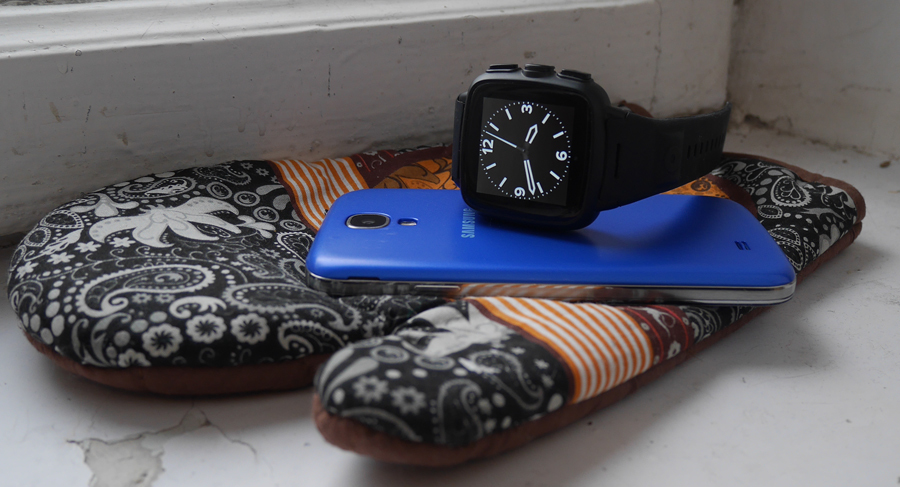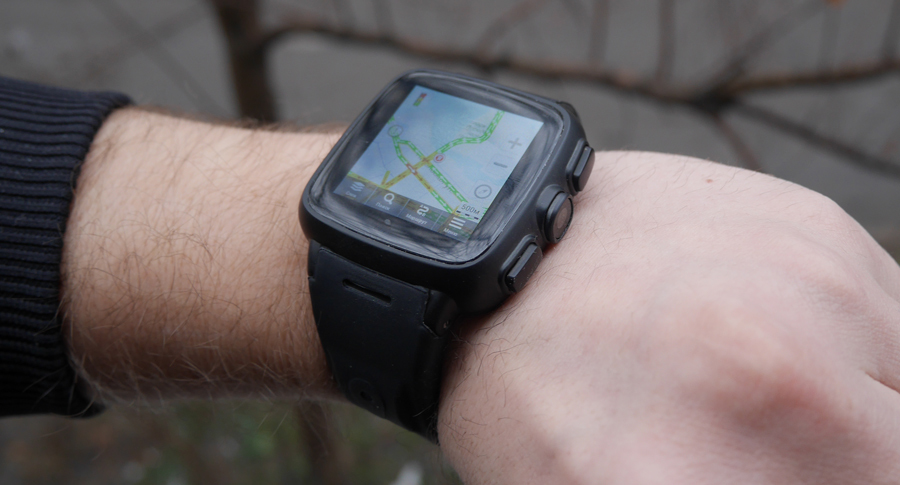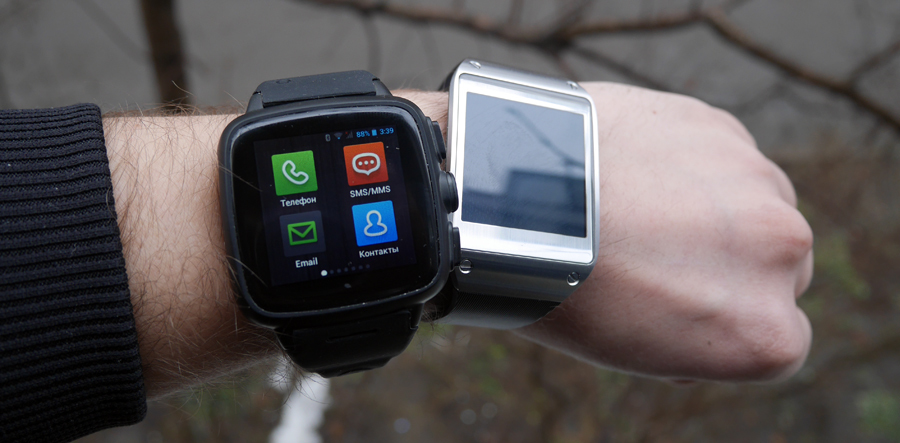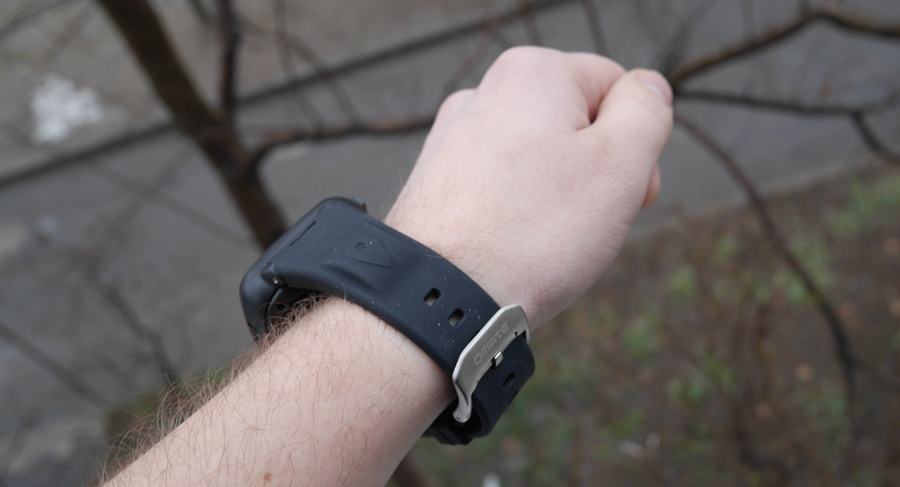A week with a watch-phone: how I exploited the Omate TrueSmart on the MediaTek chipset
I am ambiguous about “smart watches” - there is no final opinion yet, so far I just look and make intermediate conclusions. Initially, I considered these devices absolutely useless, since their functionality was minimal. For order - I prefer all the innovations to experience for myself - I even got myself a Samsung Galaxy Gear ( details here ) and, frankly, was somewhat disappointed. This device has no place in my daily life. The reason for this was a relatively meager list of possibilities and a very short battery life - the battery charge was barely enough from morning until late evening.
Think I stopped experimenting? Not at all: periodically I took fresh models of watches “to drive”, and in the end I realized that for me personally (for me personally!) Models like Omate X are best suited - without an open OS, but with a week of autonomous work. Details on the operation of these watches are also given in the link above.

Omate X Watch
But this is still not the end of my “journey” in realizing the advantages and disadvantages of smart watches as a class of devices. It remains to test the so-called "chasofon", that is, a wristwatch with a built-in cellular module and the capabilities of a smartphone. If ordinary “smart chronometers” are simply an addition to a smartphone or tablet computer, then “clock phones” not only show time and notify about incoming calls / SMS and events in social networks - they themselves are a full-fledged “smart phone”. Is that compact to such an extent that it can be worn on the arm. It was with such a device that I happened to meet - talking about the Omate TrueSmart model.
')

My Galaxy S4 was replaced by Omate TrueSmart for two weeks
Considering the rather long New Year holidays and, as a result, the absence of the need to go to work every day, I decided to conduct a kind of experiment: to hold on for at least a week without a regular smartphone, changing it to Omate TrueSmart. At the heart of this model is the chipset of the Taiwanese company MediaTek - MT6572 . However, the same hardware solution is used in all other watch-smartphones running the Android operating system, sold today in our market. For example, IconBIT Callisto 100.
Just in case, let me remind you that the MediaTek MT6572 chipset is used in a number of smartphones from a huge number of manufacturers (Lenovo, Huawei, Acer, etc.). However, for the "smart watch" this chipset was optimized in a special way. In particular, the system software "taught" to work with small screens that have low resolution, and batteries of small capacity.

MediaTek MT6572 includes a dual-core ARM Cortex-A7 processor , a Mali-400MP graphics accelerator, a set of wireless communication modules and other standard components for smartphones, but components that are not familiar to the watch. For example, a gadget even has a SIM card slot. With all this, the dimensions of the device remained quite compact. I will say more: Omate TrueSmart is quite comparable in size with the same Samsung Galaxy Gear.


Well, let me go directly to the impressions of the use of a watch-smartphone, and I will start with a "fly in the ointment." I think everyone already understands that Omate TrueSmart, like other similar devices on the MediaTek MT6572, has a full voice communication. There are absolutely no complaints about the quality of reception / transmission of speech and reception of a signal, all at the level of an average smartphone. Also note the support of work in third generation networks (3G). What I didn’t like was that during the call arrival / making, the speakerphone is activated. Therefore, if there are any people near you, they will hear not only what you say, but your interlocutor. Agree, this is not always convenient, so for more privacy you need to use a Bluetooth headset.
The main advantages of the watch-smartphones on the MT6572 as a whole and the Omate TrueSmart in particular are the impressive battery life. If you use the gadget in the active mode, the battery will last for a couple of days. Two full days of active use! Not every smartphone can boast of such indicators, not that “smart watch”. By the way, the latter are mostly “asking for the outlet” in one, maximum one and a half days. And despite the fact that smart watches constantly spend energy on communicating with cell towers, while regular models on Tizen or Android Wear spend their batteries on Bluetooth communication. Apparently, it is MediaTek's chipset that is worth giving thanks for an economical charge.

A collection of screenshots of various applications. The difference with a regular smartphone is minimal.
Let's go further. There are absolutely no complaints about the work of Wi-Fi, GPS and other wireless modules - everything is up to standard. The Omate TrueSmart touchscreen has a diagonal of 1.54 inches and a resolution of 240 x 240 pixels. Yes, it is not enough by smartphone standards, however, do not forget that this device is a watch, albeit smart, and with smartphone functions. Taking into account the indicated dimensions of the display, it becomes clear that it is unlikely to use the device as a navigator. And the gadget clearly does not pretend to the role of the game console. Although most unpretentious titles work properly. For the rest, the relatively small diagonal is not a hindrance. SMS messaging? You are welcome. Social networks? Easy. Mail, Skype, Instagram, Internet Surfing? Not a problem either. The image on the screen looks clear, but the virtual keyboard, though small, is surprisingly comfortable - I almost did not have any misses by the keys.

As for the software, Omate TrueSmart is running Android 4.2.2. Yes, this is no longer “fresh”, but precisely in the case of these watches, where the OS is covered with a simple proprietary shell optimized for square proportions of the display, this drawback is not critical.

Variants of the actual clock displayed on the screen saver
In general, I will summarize. I had a goal - to use the Omate TrueSmart smartphone watch on the MediaTek MT6572 instead of a smartphone for at least a week. However, in fact, I "lasted" almost two. Within my own apartment, I used a laptop or tablet, outside of which advanced smart watches turned out to be quite enough. Of course, I understand that in everyday life (not on vacation), when you need to spend a considerable amount of time in public transport when traveling to work, back, etc., you can “get bored” on a smartphone - you will hardly be comfortable with the clock Watch a video or read a book. But in this mode, in which I used Omate TrueSmart (meeting with relatives and friends, shopping, walking, etc.), this device was quite enough. Hours work long and steadily, plus their opportunities for most situations are enough. It is only necessary to develop new habits, which took me just a couple of days.
Think I stopped experimenting? Not at all: periodically I took fresh models of watches “to drive”, and in the end I realized that for me personally (for me personally!) Models like Omate X are best suited - without an open OS, but with a week of autonomous work. Details on the operation of these watches are also given in the link above.

Omate X Watch
But this is still not the end of my “journey” in realizing the advantages and disadvantages of smart watches as a class of devices. It remains to test the so-called "chasofon", that is, a wristwatch with a built-in cellular module and the capabilities of a smartphone. If ordinary “smart chronometers” are simply an addition to a smartphone or tablet computer, then “clock phones” not only show time and notify about incoming calls / SMS and events in social networks - they themselves are a full-fledged “smart phone”. Is that compact to such an extent that it can be worn on the arm. It was with such a device that I happened to meet - talking about the Omate TrueSmart model.
')
My Galaxy S4 was replaced by Omate TrueSmart for two weeks
Considering the rather long New Year holidays and, as a result, the absence of the need to go to work every day, I decided to conduct a kind of experiment: to hold on for at least a week without a regular smartphone, changing it to Omate TrueSmart. At the heart of this model is the chipset of the Taiwanese company MediaTek - MT6572 . However, the same hardware solution is used in all other watch-smartphones running the Android operating system, sold today in our market. For example, IconBIT Callisto 100.
Just in case, let me remind you that the MediaTek MT6572 chipset is used in a number of smartphones from a huge number of manufacturers (Lenovo, Huawei, Acer, etc.). However, for the "smart watch" this chipset was optimized in a special way. In particular, the system software "taught" to work with small screens that have low resolution, and batteries of small capacity.
MediaTek MT6572 includes a dual-core ARM Cortex-A7 processor , a Mali-400MP graphics accelerator, a set of wireless communication modules and other standard components for smartphones, but components that are not familiar to the watch. For example, a gadget even has a SIM card slot. With all this, the dimensions of the device remained quite compact. I will say more: Omate TrueSmart is quite comparable in size with the same Samsung Galaxy Gear.
Well, let me go directly to the impressions of the use of a watch-smartphone, and I will start with a "fly in the ointment." I think everyone already understands that Omate TrueSmart, like other similar devices on the MediaTek MT6572, has a full voice communication. There are absolutely no complaints about the quality of reception / transmission of speech and reception of a signal, all at the level of an average smartphone. Also note the support of work in third generation networks (3G). What I didn’t like was that during the call arrival / making, the speakerphone is activated. Therefore, if there are any people near you, they will hear not only what you say, but your interlocutor. Agree, this is not always convenient, so for more privacy you need to use a Bluetooth headset.
The main advantages of the watch-smartphones on the MT6572 as a whole and the Omate TrueSmart in particular are the impressive battery life. If you use the gadget in the active mode, the battery will last for a couple of days. Two full days of active use! Not every smartphone can boast of such indicators, not that “smart watch”. By the way, the latter are mostly “asking for the outlet” in one, maximum one and a half days. And despite the fact that smart watches constantly spend energy on communicating with cell towers, while regular models on Tizen or Android Wear spend their batteries on Bluetooth communication. Apparently, it is MediaTek's chipset that is worth giving thanks for an economical charge.

A collection of screenshots of various applications. The difference with a regular smartphone is minimal.
Let's go further. There are absolutely no complaints about the work of Wi-Fi, GPS and other wireless modules - everything is up to standard. The Omate TrueSmart touchscreen has a diagonal of 1.54 inches and a resolution of 240 x 240 pixels. Yes, it is not enough by smartphone standards, however, do not forget that this device is a watch, albeit smart, and with smartphone functions. Taking into account the indicated dimensions of the display, it becomes clear that it is unlikely to use the device as a navigator. And the gadget clearly does not pretend to the role of the game console. Although most unpretentious titles work properly. For the rest, the relatively small diagonal is not a hindrance. SMS messaging? You are welcome. Social networks? Easy. Mail, Skype, Instagram, Internet Surfing? Not a problem either. The image on the screen looks clear, but the virtual keyboard, though small, is surprisingly comfortable - I almost did not have any misses by the keys.

As for the software, Omate TrueSmart is running Android 4.2.2. Yes, this is no longer “fresh”, but precisely in the case of these watches, where the OS is covered with a simple proprietary shell optimized for square proportions of the display, this drawback is not critical.

Variants of the actual clock displayed on the screen saver
In general, I will summarize. I had a goal - to use the Omate TrueSmart smartphone watch on the MediaTek MT6572 instead of a smartphone for at least a week. However, in fact, I "lasted" almost two. Within my own apartment, I used a laptop or tablet, outside of which advanced smart watches turned out to be quite enough. Of course, I understand that in everyday life (not on vacation), when you need to spend a considerable amount of time in public transport when traveling to work, back, etc., you can “get bored” on a smartphone - you will hardly be comfortable with the clock Watch a video or read a book. But in this mode, in which I used Omate TrueSmart (meeting with relatives and friends, shopping, walking, etc.), this device was quite enough. Hours work long and steadily, plus their opportunities for most situations are enough. It is only necessary to develop new habits, which took me just a couple of days.
Source: https://habr.com/ru/post/375943/
All Articles